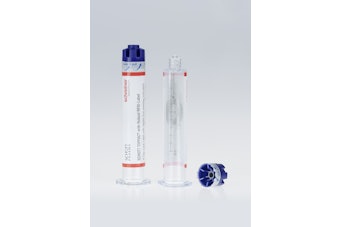
"An isolator is a fully sealed unit that runs under slight positive pressure to the outside, so the air on the inside is protected via pressure differential," explains Eric Isberg, product manager for Bosch Packaging Technology , a division of The Bosch Group that focuses on liquid pharmaceutical filling machinery and manufactures cleanroom equipment, RABS, and isolators. "A RABS is open, in most cases, so the air flows freely out of the RABS and into the surrounding room. The second difference between an isolator and a RABS is an isolator has an automated biodecontamination system that uses vaporized hydrogen peroxide. Cleaning a RABS is usually a manual process."
In the last few years, isolators have started to gain acceptance again due to better technology and a reduced cleaning cycle. But when it comes to making a choice between cleanrooms and RABS or isolators, the pharmaceutical industry is divided.
"There's a debate, especially in the U.S., about cleanrooms versus RABS or isolators," says Isberg. "RABS and isolators are expensive. They can double the cost of a filling line. It's a new piece of equipment that has to be maintained and operated correctly, and there's a learning curve. The company has to go through a paradigm shift to embrace either technology if it's currently using cleanrooms."
Despite the equipments' price tag, some say the additional expenses related to operating a cleanroom have to be taken into account as well: "Energy costs, operating costs, and testing costs to prove the entire room is clean are phenomenal," says Sterling Kline, a design consultant at IPS , a company that offers consulting, design, and validation services to the pharmaceutical industry. "I worked on a project where one room's air conditioning cost was equal to the company's 200,000-square-foot building." In addition, operators spend an average of two hours a day gowning and degowninghours that they are being paid for, he says.
One thing the industry does seem to agree on, however, is that people are the largest source of contamination in a cleanroom, hence RABS and isolators are a physical barrier that separates people from the filling process. The greater controversy seems to be whether or not RABS is an advanced aseptic process.
RABS versus isolators
Guidance for Industry- Sterile Drug Products Produced by Aseptic Processing Current Good Manufacturing Practice, defines an isolator as a decontaminated unit, supplied with Class 100 (ISO 5) or higher air quality, that provides uncompromised, continuous isolation of its interior from the external environment (e.g., surrounding cleanroom air and personnel).
To address the industry's confusion about RABS, an International Society for Pharmaceutical Engineers team came up with a definition white paper for RABS in 2005. The team was led by Jack Lysfjord, principal consultant, Lysfjord Consulting LLC, a firm that offers consulting for aseptic processing issues for injectable drugs with emphasis on the use of RABS and isolators.
According to the white paper, RABs' characteristics include "use of glove port(s), half suit(s) and/or automation to access all areas of the enclosure which need to be reached by an operator during filling operations." The white paper also states "some processes may include rare open door interventions."
"The problem is how each person defines what a restricted access barrier system is," says Lysfjord. "I emphasize 'system' because it is not the enclosure only but all aspects of the system that provide product and patient benefit by reducing risk." Some companies never open a RABS, he says, while others open them occasionally and some open them frequently. "Each opening greatly increases contamination risk and can create a situation where the risk is worse than equipment in a conventional cleanroom," says Lysfjord. "Part of the 'system' is the operating philosophy. If you never open the door, it's a RABS, and if you open the door frequently on the same enclosure it is not a RABS."
RABS can be opened infrequently for defined, controlled processes. "You call it an intervention and you document it and do a line clearance," he says. "You need to define it in your Standard Operating Procedures as to how people should behave and define each kind of intervention you can do. Some people think because it's a RABS it gives you protection like it's magic. That's not true. If you open the door you create particles."
Jim Agalloco, president of Agalloco & Associates, a firm that offers technical services to the pharmaceutical and biotechnology industries, says that the point of contention is between a closed RABS and an open RABS. He does not believe that RABS is an advanced aseptic process. "Advanced aseptic processing is processing without people," he says. "RABS is almost there but not quite. A closed RABS is as close to an isolator as you can get; however, an open RABS allows an operator to open the door and access the machine. The open RABS is like saying I have an unrestricted restricted access barrier system. If I can open the door, then where's my restriction?"
Kline makes no attempt to hide his disdain for RABS. "My definition of RABS is ridiculous attempt being sterile," he says. "I don't know that anyone has proved how to clean the inside of the machine. Unlike isolators, they aren't cleaned with VHP (vapor hydrogen peroxide). Also, you have to put a RABS in an aseptic facility, so you've taken the two most expensive things, combined them, and it's still incredibly difficult to validate that you've cleaned it well."
Yet some companies favor RABS for the very reason that others disregard the technology as advanced aseptic processing: Accessibility. "It gives them more flexibility because you can open the doors," says Isberg. "One of the things that scare people about isolators is that you can't get into that process when it's running."
Isberg is also seeing a trend among customers requesting RABS units without glove ports. "Gloves have always been more work," he says. "You have to inspect them on a daily basis. In an isolator, gloves are the primary route to contamination, and glove failures are the most common failures within an isolator system."
No doubt, the debate is far from over. "Both of these technologies have places, and both are better than cleanrooms," says Agalloco. "The question is how much better do you need? Time will tell us if either of these has staying power."
--By Kassandra Kania, Contributing Editor



















